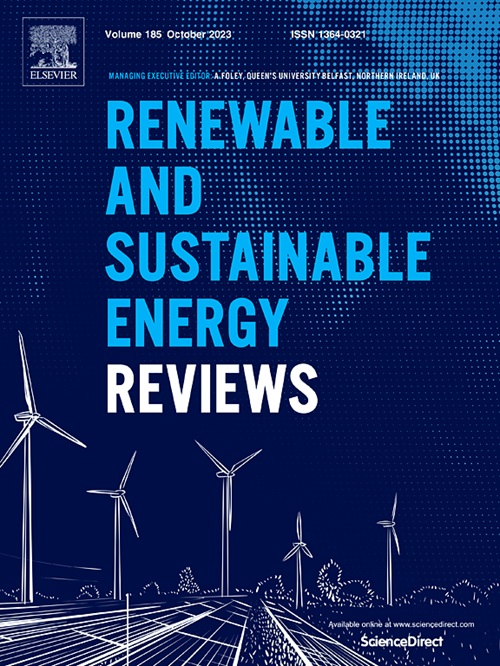Exploring the development path of bioenergy carbon capture and storage for achieving carbon neutrality in China: A systematic review
IF 16.3
1区 工程技术
Q1 ENERGY & FUELS
引用次数: 0
Abstract
Bioenergy carbon capture and storage (BECCS) is essential for achieving carbon neutrality targets, whereas relevant demonstration projects have not yet been prioritized in China. This study attempts to investigate the development path of BECCS in China through mapping out a spatial and temporal development path considering practice advantages and underlying difficulties. It suggests that small-scale demonstration projects should be implemented before 2030 when biomass technologies should evolve from fuel substitution to material substitution. Between 2030 and 2040, large-scale biomass co-firing related BECCS projects can be deployed as a result of the maturation of biomass pretreatment technologies and second-generation capture technology, potentially leading to an emissions reduction of 80–100 Mt/a. In light of the challenges in source-sink matching, the early projects characterized with vertical integration and joint venture business models may be concentrated in the Northeast, North and East areas. Beyond 2040, advancements in combined fuel & material substitution and other integrated zero or negative carbon technologies are likely to facilitate pure biomass burning-related BECCS projects with emission reduction ranging from 300 to 600 Mt/a. By then, the flexible BECCS operator and transport operator business models can be promoted. Notably, if CO2 utilization technologies and offshore storage technologies are proven feasible, large-scale deployment can be achieved in the biomass-rich southwest and southeast Coastal areas. However, the northwest area may face restrictions due to limited scarce biomass resources. Additionally, intensive biomass collection mode, potential environmental damages (e.g. water consumption), global cooperation mechanism, etc. should also be highly regarded.
探索中国实现碳中和的生物能源碳捕集与封存发展路径:系统综述
生物质能碳捕集与封存(BECCS)是实现碳中和目标的关键,而相关示范项目在中国尚未得到优先考虑。本研究试图通过绘制时空发展路径图,考虑实践优势和潜在困难,研究中国生物能源碳捕集与封存的发展路径。研究建议在 2030 年之前实施小型示范项目,此时生物质技术应从燃料替代发展到材料替代。2030 至 2040 年间,随着生物质预处理技术和第二代捕集技术的成熟,可部署大规模生物质联合燃烧相关的 BECCS 项目,从而可能实现 8000 万至 1 亿吨/年的减排量。鉴于源汇匹配方面的挑战,以垂直整合和合资商业模式为特征的早期项目可能集中在东北、华北和华东地区。2040 年以后,联合燃料&、材料替代和其他零碳或负碳综合技术的进步可能会促进与纯生物质燃烧相关的 BECCS 项目,其减排量在 3 亿吨/年到 6 亿吨/年之间。届时,灵活的 BECCS 运营商和运输运营商的商业模式将得到推广。值得注意的是,如果二氧化碳利用技术和海上封存技术被证明是可行的,那么在生物质丰富的西南和东南沿海地区就可以实现大规模部署。然而,由于生物质资源稀缺,西北地区可能面临限制。此外,生物质的集约化收集模式、潜在的环境破坏(如耗水)、全球合作机制等也应引起高度重视。
本文章由计算机程序翻译,如有差异,请以英文原文为准。
求助全文
约1分钟内获得全文
求助全文
来源期刊

Renewable and Sustainable Energy Reviews
工程技术-能源与燃料
CiteScore
31.20
自引率
5.70%
发文量
1055
审稿时长
62 days
期刊介绍:
The mission of Renewable and Sustainable Energy Reviews is to disseminate the most compelling and pertinent critical insights in renewable and sustainable energy, fostering collaboration among the research community, private sector, and policy and decision makers. The journal aims to exchange challenges, solutions, innovative concepts, and technologies, contributing to sustainable development, the transition to a low-carbon future, and the attainment of emissions targets outlined by the United Nations Framework Convention on Climate Change.
Renewable and Sustainable Energy Reviews publishes a diverse range of content, including review papers, original research, case studies, and analyses of new technologies, all featuring a substantial review component such as critique, comparison, or analysis. Introducing a distinctive paper type, Expert Insights, the journal presents commissioned mini-reviews authored by field leaders, addressing topics of significant interest. Case studies undergo consideration only if they showcase the work's applicability to other regions or contribute valuable insights to the broader field of renewable and sustainable energy. Notably, a bibliographic or literature review lacking critical analysis is deemed unsuitable for publication.
 求助内容:
求助内容: 应助结果提醒方式:
应助结果提醒方式:


